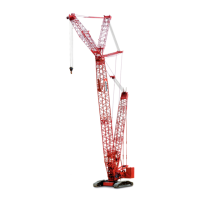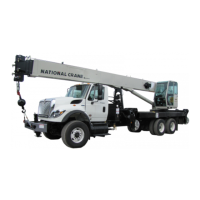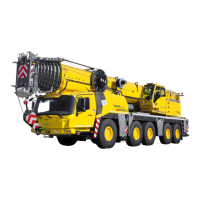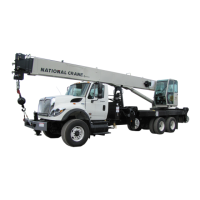HYDRAULIC SYSTEM 18000 SERIVCE/MAINTENANCE MANUAL
2-38 Published 12-05-17, Control # 035-23
5. Loosen lock nut (2).
6. Using an internal hex wrench, turn adjusting screw (3) in
until pressure increases in either gauge.
7. Note angular position of internal hex wrench.
8. Then, turn adjusting screw out until pressure increases
an equal amount in other gauge.
9. Again, note angular position of internal hex wrench.
10. Turn adjusting screw in half the distance between
positions noted above.
11. Pump control should now be in neutral with both gauges
reading same pressure.
12. Hold adjusting screw (3) in position and securely tighten
lock nut (2).
13. Stop engine, remove gauges, and securely install servo
gauge port plugs (1).
Motor Leakage Test
Perform the following test if troubleshooting indicates the
need:
• Low Charge Pressure
• Sluggish Operation
• Excessive Heat
See Figure 2-31
for the following procedure.
1. Stop engine.
2. Install an accurate flow meter in highest case drain port
(see Figure 2-16
) at desired motor.
• A 3,000 psi (207 bar) in-line meter with a flow rate of
30 gpm (114 L/m) is required.
• All motors except swing require 16 ORS fittings.
Swing requires 12 ORS fittings.
3. For hoist motors only, disable loop flushing as follows:
a. Disconnect loop flushing hose (2) from elbow in loop
flushing valve (1).
b. Install an 08 ORS cap on end of elbow and an 08
ORS plug in end of hose.
4. Start and run engine at high idle.
5. Monitor flow meter. Under all operating conditions,
leakage should not be more than 1-1/2 to 2-1/2 gpm (5,7
to 9,5 L/m.
6. Stop engine and enable loop flushing by reconnecting
hose to elbow in loop flushing valve.
7. Start and run engine at high idle.
8. Monitor flow meter. Under all operating conditions,
leakage should not be more than 5-1/2 to 6-1/2 gpm
(20,8 to 24,6 L/m).
9. If motor leakage without loop flushing is not within
specified range, replace motor and pump.
10. If motor leakage with loop flushing is not within specified
range, replace loop flushing valve and/or motor and
pump depending on which is the cause for high leakage.
Loop Flushing Valve Adjustment
The loop flushing valves for the hoists – load and boom – are
not adjustable. Do not tamper with settings of valve
cartridges in loop flushing valve manifold.
If you are experiencing excessive leakage do to a faulty loop
flushing valve, replace valve.
Manual Override Tests
The pumps, motors, and solenoid valves have manual
overrides that allow electrical problems to be isolated from
mechanical problems when troubleshooting hydraulic
system problems.
FIGURE 2-31
Typical Motor Installation
Item Description
1 Loop Flushing Valve
2 Loop Flushing Hose
3Motor
1
2
3
P2297b

